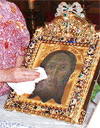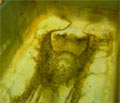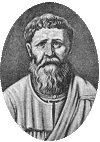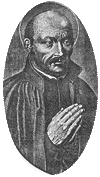Christ! Mandylion or 'Holy Face of Edessa'
Would You BELIEVE IT?!
Self-portrait by the artist Jesus Christ!Legend has it that Jesus sent his portrait (which miraculously appeared on a cloth pressed to his face) to King Agbar of Edessa.
The Greek word "μανδύλιον" [mandylion] comes from the Semitic word "mindil", a handkerchief.
On the other hand ...
Not to be outdone, the Christian West concocted the story of 'Veronica', a good woman who wipes the face of JC and whose cloth then miraculously bears his image.
Good for business, of course...
The Veronica of Jaen (Spain).
Not to be confused with the Veronica in Milan or the Veronica in the Vatican. All genuine, of course.
In order to withstand obvious doubts about replicated relics (multiple heads of John the Baptist, for example) the Church espoused the wondrous truth that 'self-replication' was further evidence of a relic's miraculous qualities.
"Sudarium of Oviedo"
(that's a dirty stained cloth to the sane)
The 12th century Kingdom of Castile and Leon, with its warriors ravaging Moorish Spain, needed sacred relics to heighten religious tension.
Archbishop Pelayo Meléndez, "the chronicler", came up with "relics from the Holy City of Jerusalem", including a blood stained rag said to be the face cloth of one dead Jesus referred to in John 20.7. Still a prized tourist attraction in the Cathedral.
Oviedo was a small detour from the pilgirm trail to Santiago de Compostela.
Why not start your own shrine?
Christmas 2005 and Jesus shows up in a cooking pan. One lucky fast food worker has now retired to West Palm Beach as thousands flock to see the "Grease smear Jesus."
All Liars
'Only lies have our fathers handed down to us, emptiness in which there is nothing of any avail!'
– Jeremiah 16.19.
A Lying Prophet
'And Elisha said unto him, Go, say unto him, "Thou mayest certainly recover": howbeit the LORD hath shewed me that he shall surely die.'
– 2 Kings 8.10.
Monstrous fiction
'Clearly the Christians have used ... myths ... in fabricating the story of Jesus' birth ... It is clear to me that the writings of the Christians are a lie and that your fables are not well-enough constructed to conceal this monstrous fiction.'
– Celsus (On The True Doctrine, c178 AD)
Celsus was one of the foremost thinkers of his age. His critique of the Christians was so damaging that Christians destroyed every copy of his work they could find.
Useful, Not Truthful
'To confute the opposer ... one argues as one pleases, saying one thing while one means another ... Origen, Eusebius [et al] write at great length ... Sometimes it is true, they are compelled to say not what they think but what is useful.'
– St Jerome, c. 380.
It's Official – One-Eyed Men!
"I was already Bishop of Hippo, when I went into Ethiopia with some servants of Christ there to preach the Gospel. In this country we saw many men and women without heads, who had two great eyes in their breasts; and in countries still more southly, we saw people who had but one eye in their foreheads.'"
– St Augustine
(Sermon 37; quoted in Taylor, Syntagma, 52; Diegesis, 271; Doane, Bible Myths, 437.)
'On Lying'
Believe it or not, Augustine devoted two whole treatises to the topic of lying. The first of these, 'De mendacio' ('On Lying'), written in 395, discussed the pros and cons of lying.
On balance, of the eight kinds of lie which he identified (each with several sub-types!) he excused 'jocular' lies, was 'uncertain' about others (depending on motive and the likelihood of being believed) but questioned the morality of the remainder.
The second tract 'Contra mendacium', written in 422, cautioned the brethren against lying. Evidently they needed the warning.
"One never errs more safely, methinks, than when one errs by too much loving the truth, and too much rejecting of falsehood."
– St Augustine, Retractations, Book I
Father of Lies?
"All scripture is given by inspiration of God"
– 2 Timothy 3.16."And for this cause God shall send them strong delusion, that they should believe a lie."
– 2 Thessalonians 2.11
It's Official – White is Black!
Ignatius Loyola – Jesuit Fuhrer
Pious Forgeries
'The forgery of pious documents of every imaginable character was among the most constant and zealous activities of the holy propagandists of the Christian Faith, from the beginning to the critical era when forgeries were no longer possible or profitable.'
– Joseph Wheless (1930)
Suspect
"Unsigned works are a peculiar Christian phenomenon, in works with a dogmatic, apologetic, and propagandistic aim – in other words, works already suspect, and thus made even more so by an author's anonymity."
– Richard Carrier
"Letter of Jesus to the King of Edessa"
Would You BELIEVE IT?! JC replies to a royal fan!
Useful, Not Truthful
"It is usual for the sacred historian to conform himself to the generally accepted opinion of the masses in his time.'
– St Jerome (P.L., XXVI, 98; XXIV, 855).
What a Girl! Our Lady of Guadeloupe conveniently turned up to help the murdering conquistadors in the Americas.
Would the partisans of Christ have set out deliberately to lie? Were they such barefaced charlatans that they concocted falsehoods and deceits merely to advance themselves and their designs? By their own admission, YES they were. They may well have been believers, in that they held to a certain faith. On this was built the fanaticism either to die, or to kill others, for that faith. But faith absolves the believer from any fidelity to objective truth.
God's Truth – Lies Religious fantasy advances in small steps by which those who already ‘see a higher truth’ help the less gifted to achieve that sublime state by using various devices. In Jewish tradition, one such a device was ‘midrash’, the teasing out of new, contemporary meanings from antique, sacred texts. By such means, the scribes could resolve a current issue by interpreting what the scripture had ‘really meant’ all along. Was that a lie? False accreditation was another much used method, common practice during antiquity. Most of the texts in both the Hebrew bible and the New Testament were forged in the names of their authors to give them ‘authority.’ This merely helped others recognise 'the higher truths' presented to them. Who could argue with Solomon, say, or Apostles of the Lord? A Labyrinth of Deceit One of the most inveterate forms of imaginative creation was the invention of sayings and whole speeches which, just as fiction-writers do today, they put entire into the mouths of the personages of whom they were writing. Thus, in the Gospel of John, chapters 13, 14, 15, 16 and 17 are almost one continuous verbatim monologue – all three thousand six hundred words of it! – supposedly uttered by the godman, a truly remarkable instance of total recall by the fabled octogenarian author! The authors
of Christianity were fond of allegory and parable.
Few people have a head for pure theology. Popularising a convoluted
point of theology for the unlearned by an illustrative story
gets the point across. What perhaps is missed is that Christian
theology is several levels deep: it uses fictional characters
to tell fictional stories to make doctrinal points. Some dogmatists
no doubt believed (still believe) that one day, long ago, a real
whale swallowed a real Jonah. After all, Jesus supposedly said:
The theological point could be made simply – ‘our god loves all who repent, don’t be reluctant, go and tell it to the heathen’ – but would that entertain the crowd? Simple folk of course would start to take the entertaining story as a literal truth. Then, several generations later, when the story falls into the hands of the author of Matthew – who may well believe that the Jonah story is ‘true’ – he has his own fictional Christ figure quote Jonah to give authority to a different theological point: ‘death can be conquered.’ Deception Thus by small steps a complex weave of fantasy is woven. As indeed the Church Fathers cheerfully admit:
Luminaries of Deception
Thus eminent ‘believers’ added falsehood to the beliefs of later generations. ‘For the best of reasons’ they ‘clarified’ obscure points, conjured up characters to speak dialogue that could have been said, invented scenarios that could have happened, borrowed extensively from a wider culture. And this all before they became the custodians of power and had real reasons for lies, inventions and counterfeits. As we shall see, god’s immutable laws became as flexible as putty. The 5th and 6th centuries was the 'golden age' of Christian forgery. In a moment of shocking candour, the Manichean bishop (and opponent of Augustine) Faustus said:
Once the Church had grabbed mastery of much of Europe and the middle-east, its forgery engine went into overdrive.
Ignatius Loyola (1491-1556), the tireless zealot for papal authority – he was the founder of the Society of Jesus (the Jesuits) – even wrote:
The Forgery Mill Notable Christian forgeries include: The Donation
of Constantine – 'Without doubt a forgery...'
Catholic Encyclopedia In truth, this monstrous 8th century forgery (peppered with anachronisms) was almost certainly written by the future Pope Paul I (757-67) while his equally ambitious brother Stephen II (752-57) sat on the papal throne.
A similar collection, the 'Dionysiana', was named for a 6th century monk 'Dennis the Little' (Dionysius Exiguus), inventor of the BC -AD dating system. Dionysius provided the papacy with Latin translation of the canons the Eastern Church. This ripe collection included fifty canons from the very Apostles themselves.
We know in graphic detail the course of the first Jewish War because – remarkably – the history recorded by Josephus somehow survived. Whereas whole libraries of antiquity were torched by the Christians, curiously, this testimony of a Jew made it through the centuries. A subsequent work by Josephus, The Antiquity of the Jews, which iterated and extended his story of the 'chosen people' also survived. The survival of these two overlapping works was no coincidence because they rather too well 'confirm' from a 'non-Christian source' the existence of the godman. In short, sometime in the 4th century, while most else of ancient scholarship was being thrown into bonfires, a Christian scribe – probably Eusebius, Bishop of Caesarea– 'rescued' the histories of Josephus and 'doctored' them to provide convenient 'proof' that Christ had been flesh-and-blood and was neither a fiction (as pagan critics maintained) nor solely a spiritual being, as gnostics reasoned. (See full discussion: The authentic pen of lying Christian scribes!)
The Jewish historian Josephus says nothing about any "persecution" under Nero, though he is not slow to describe him as "acting like a madman" who "slew his brother, and wife, and mother, from whom his barbarity spread itself to others that were most nearly related to him; and how, at last, he was so distracted that he became an actor in the scenes, and upon the theater." (Wars, 13.1) If a bonfire of Christians had actually happened Josephus would have mentioned it – but he does not, and nor does any early Christian writer.
Chapter 16 of Life of Nero by Suetonius. This is the origin of the 'Christians burnt as torches' nonsense.
The letter was first printed in the "Life of Christ" by Ludolph the Carthusian (Cologne, 1474). It was probably composed in 13th/14th century, based on an earlier Greek forgery.
Letter
of Jesus to the King of Edessa
The Greek-speaking translators of Hebrew scripture (in 3rd century B.C. Alexandria) slipped up and translated 'almah' (young woman) into the Greek 'parthenos' (virgin). The Hebrew word for virgin would have been 'betulah.' The slip did not matter at the time, for in context, Isaiah’s prophecy – set in the 8th century BC but probably written in the 5th – had been given as reassurance to King Ahaz of Judah that his royal line would survive, despite the ongoing siege of Jerusalem by the Syrians. And it did. In other words, the prophecy had nothing to do with events in Judaea eight hundred years into the future! Justin ‘Martyr’, a pagan Greek from Palestine, fled to Ephesus at the time of Bar Kochbar’s revolt (132 -135 AD). He joined the growing Christian community and found himself competing with the priests of Artemis, an eternally virgin goddess. Justin successfully overcame the sentiments of established Christians and had Mary, mother of Jesus, declared a virgin, citing his Greek copy of Isaiah as 'evidence' of scriptural prescience. The Greek priest who then forged the 'Gospel according to St. Matthew' went one stage further, taking the word 'harah' – in Hebrew a past or perfect tense – and switched it into a future tense to arrive at:
The Pope has chosen to canonise Juan Diego, supposedly a sixteenth century Mexican Indian who had the good fortune to have the Blessed Virgin (in the guise of 'Our Lady of Guadeloupe') impress her own image onto his cloak. Not surprisingly, Diego was a paragon of Catholic devotion, completely submissive to Spanish colonial authorities. Mind you, the story only surfaced a century after its alleged occurrence, at the height of the campaign to eradicate indigenous religions. Commented David Brading, Professor of Mexican History at Cambridge University:
Whether we look at the Middle Ages and the Reformation, the first centuries of the Christian era or even today, Christianity has always been a fabrication, layer set upon layer of lies and nonsense, a fraud from its very inception.
Sources:
'Save' a friend e-mail this page
Copyright © 2004,2007
by Kenneth Humphreys.
|
||||||||||||||||||||||||||||||||||||||||||||||||||||||











